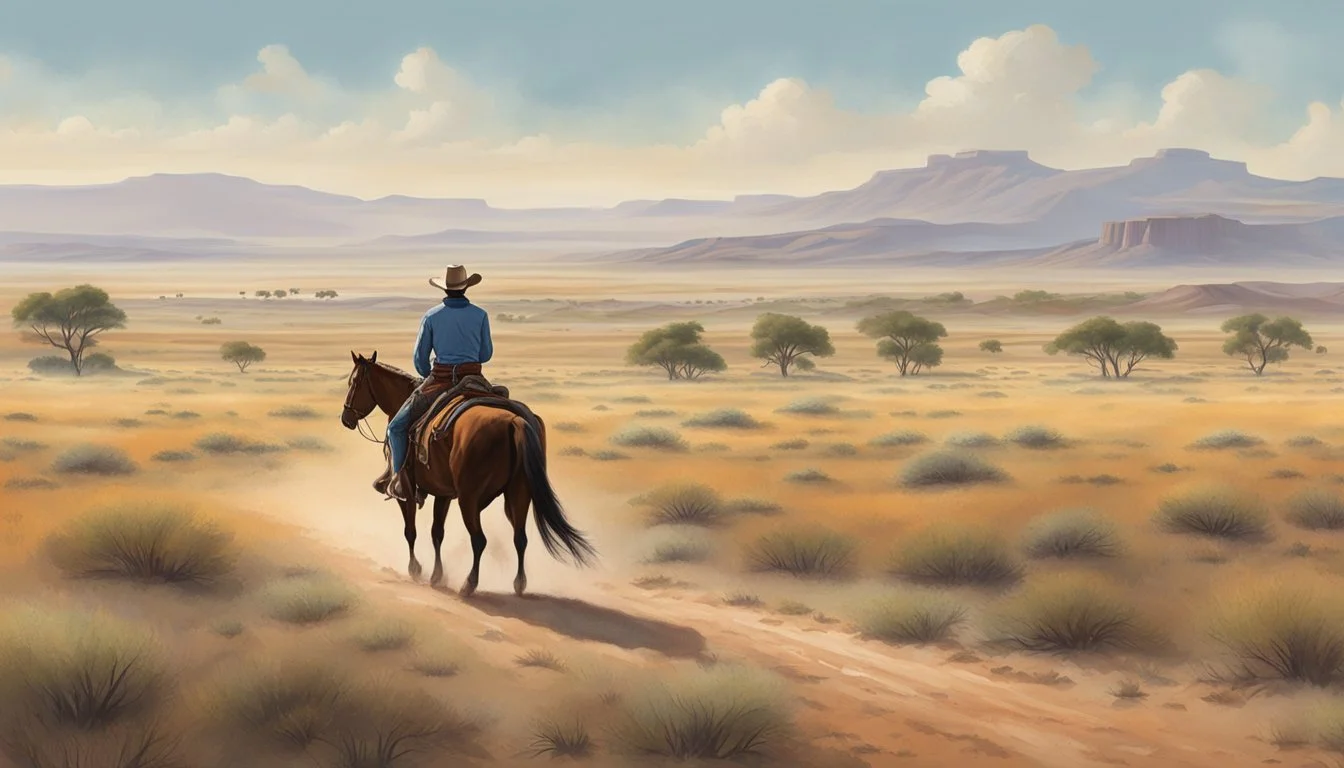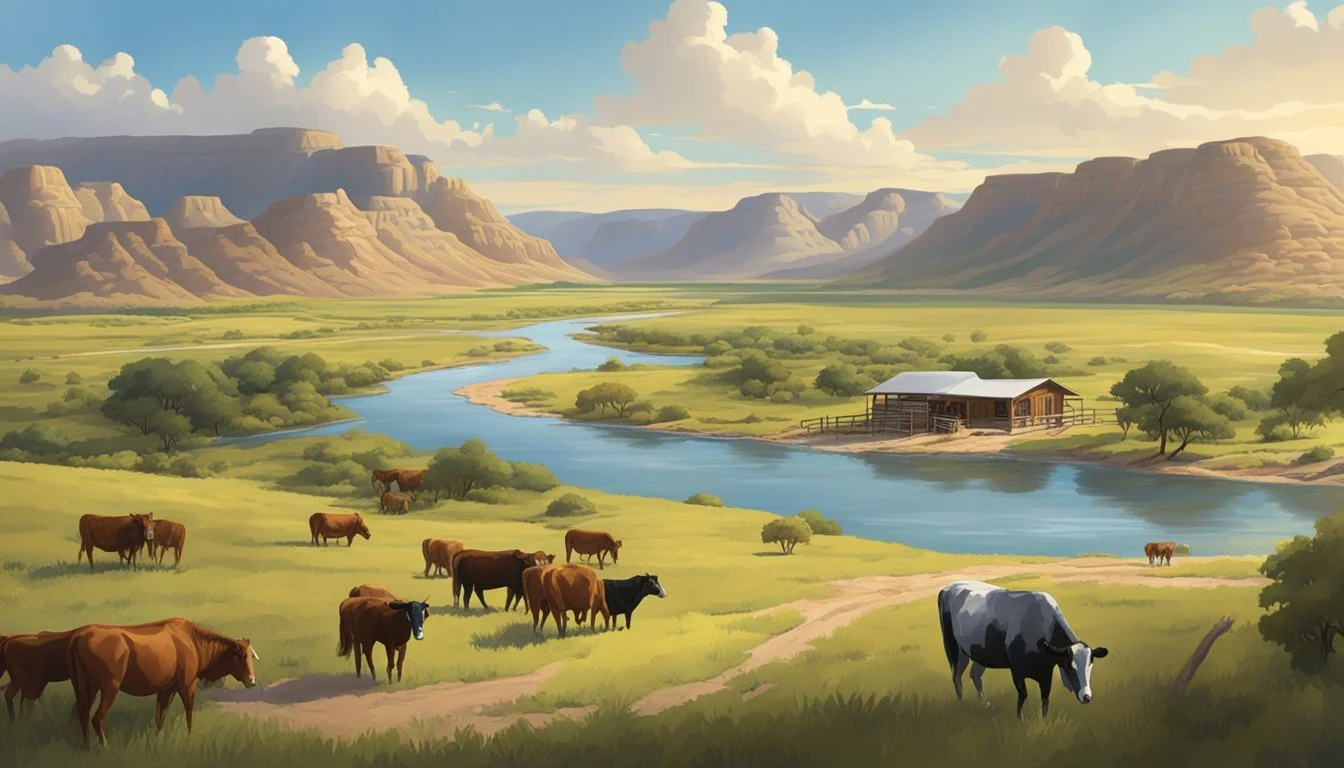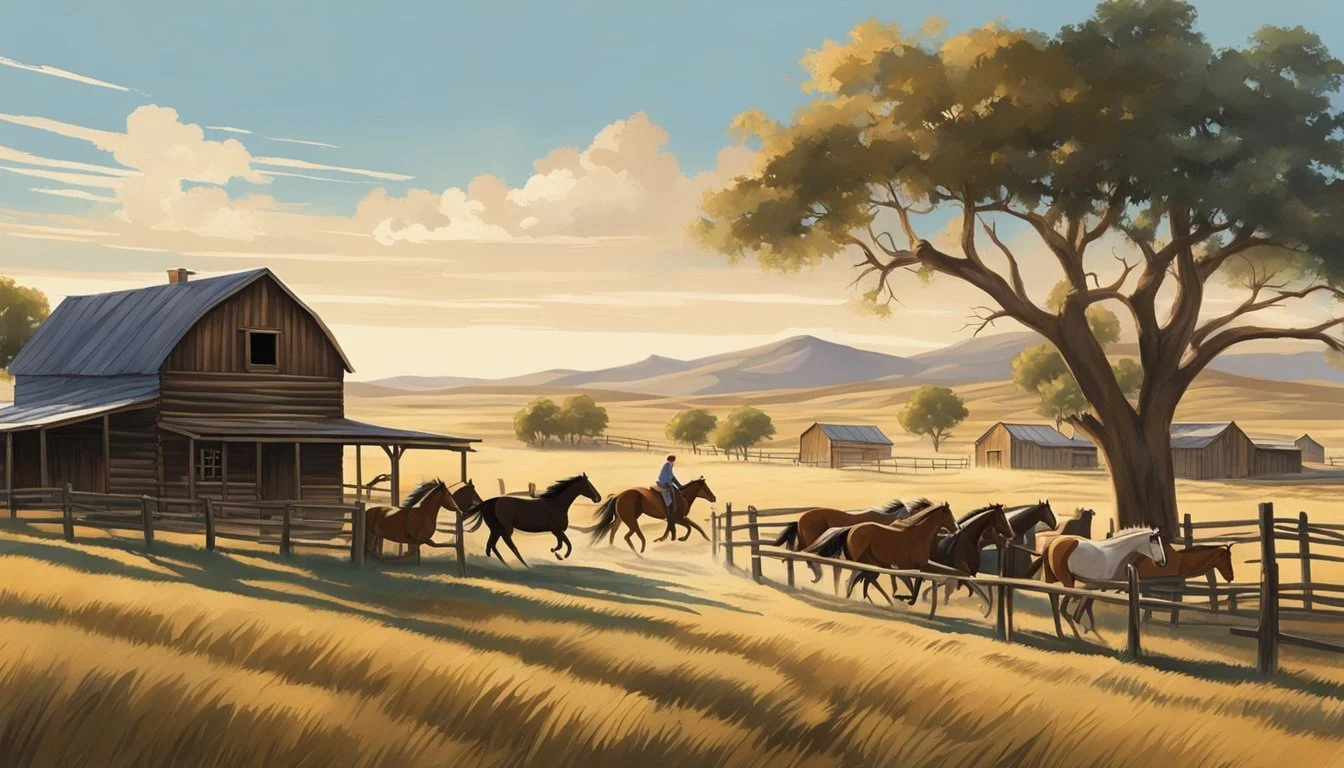The History of the King Ranch
Exploring the Legacy of a Texas Icon
Established in the rugged expanse of South Texas, King Ranch is not only a bastion of the state's pastoral heritage but also a symbol of the American ranching tradition. Sprawling over hundreds of thousands of acres, this historic institution traces its origins back to a 15,500-acre Spanish land grant acquired by Richard King. A riverboat captain turned rancher, King transformed these humble beginnings into a legendary cattle empire that played a pivotal role in shaping the cowboy culture of Texas and beyond.
Since its inception, King Ranch has evolved to become much more than a mere cattle ranch; it's an institution that embodies the pioneering spirit that is often associated with the American West. Through innovation, resilience, and a strong commitment to land stewardship, the ranch has weathered economic fluctuations, changing industries, and the challenging Texas wilderness to maintain its position as a leader in ranching.
The narrative of King Ranch is deeply entwined with the state of Texas, bearing witness to over a century and a half of history. It stands today as a testament to the vision of Richard King and his successors. The legacy includes not only the vast acreage and livestock but also the King Ranch's role in the community and influence in the agricultural world, which have cemented its place in American history.
King Ranch Origins
The inception of King Ranch can be traced back to a Spanish land grant and the entrepreneurial spirit of Captain Richard King, a riverboat captain who transformed a tract of wild Texas land into one of the most storied and influential ranches in the United States.
Spanish Land Grant
The history of King Ranch begins in 1852, when Richard King and his partner, Gideon K. Lewis, established a cattle camp on Santa Gertrudis Creek in South Texas. Shortly afterward, in 1853, they made their first land purchase, acquiring Rincón de Santa Gertrudis. This original plot was part of a larger Spanish land grant, which consisted of 15,500 acres. The land was lush with grass and water sources, essential for cattle ranching, and situated in present-day Nueces County.
Captain Richard King
Richard King, born in 1824, started his career as a riverboat captain. He later ventured overland and co-founded King Ranch. With sharp foresight and determination, King expanded the ranch acreage exponentially. His marriage to Henrietta, who was equally determined, further solidified the ranch’s growth and prosperity. Together, they built a ranch that surpassed even their lofty ambitions, eventually covering more than 825,000 acres—a testament to their shared vision and tenacity in the face of the rugged South Texas landscape.
Growth and Expansion
The King Ranch's history is marked by significant land acquisitions and innovations in ranch operations that have fortified its status as an emblematic Texas institution.
Acquiring Land
In its early years, the King Ranch steadily amassed land, beginning with a modest purchase of 15,500 acres in South Texas. Richard King, the ranch's industrious founder, strategically expanded the property through additional land acquisitions, ultimately growing the ranch to encompass over 825,000 acres. These expansions allowed for extensive cattle herding and agriculture, reinforcing the ranch's foundation.
Ranch Diversification
Under the watchful management of its founders, the King Ranch diversified beyond traditional cattle ranching. They began breeding their own Longhorn cattle, which were resilient to the local environment. Alongside livestock, the ranch incorporated farming practices, cultivating a variety of crops. The ranch's community, which included the Kineños (a loyal workforce of Mexican descent), was instrumental in both livestock management and agricultural endeavors. This diversification was key to the ranch's enduring legacy and economic stability.
Cattle and Breeding Innovations
King Ranch's foray into cattle breeding has led to significant agricultural advancements, especially with the development of the Santa Gertrudis breed and progressive livestock management techniques.
Introduction of the Santa Gertrudis
The Santa Gertrudis breed is a hallmark of King Ranch's innovative approach to cattle. Created from a cross between Brahman and Shorthorn cattle, the Santa Gertrudis was recognized as a distinct breed in 1940, making it the first beef breed formed in the United States. They are known for their superior beef quality, and their ability to thrive in harsh, arid climates has made Santa Gertrudis cattle a dominant breed in regions like Australia.
Livestock Management
King Ranch didn't only lead in terms of breeding but also in improving overall livestock management practices. Early adoption of dipping vats by 1891 to control the Texas Fever Tick vastly improved the health of their herds. The ranch also pioneered the use of artesian wells to provide a reliable water source for their cattle. Through such innovations, King Ranch contributed to better herd health and the growth of small communities, cementing its legacy in efficient and sustainable cattle raising.
The Cowboy Culture
The King Ranch in Texas stands as a testament to the enduring legacy of cowboy culture, a distinctive lifestyle that shaped the American West. At the heart of this culture are the skilled vaqueros and the everyday challenges of ranch life that together forge a storied tradition.
Kineños and Vaqueros
On the King Ranch, the Kineños—descendants of the original families who started with the ranch, often Mexican workers—alongside vaqueros (Spanish for cowboys), were paramount to the ranch's operation. These individuals were adept horsemen and cattle handlers, embodying the skillful and resilient spirit of the cowboy. They were instrumental in cultivating the cowboy traditions that King Ranch is renowned for. Through their intimate knowledge of the land and livestock, they developed ranching techniques that have become benchmarks in cowboy culture.
Horse Riding and Roping Skills: Vaqueros were celebrated for their exceptional horse riding and roping abilities, skills that are fundamental to successful cattle herding.
Cattle Branding: The practice of branding cattle, essential for identifying ownership, was a significant aspect of their duties.
Everyday Life on the Ranch
The daily life of a cowboy on the King Ranch was governed by the rising and setting of the sun and driven by the rhythms of ranch work. Life was structured but filled with the rigors associated with managing vast herds of cattle across extensive landscapes.
Daily Tasks: Included patrolling fence lines, tending to sick animals, and managing the herding and moving of cattle.
Seasonal Work: Cowboys faced different challenges with each season, from branding in the spring to roundups and drives in the fall.
Cowboys lived by a code of hard work, respect for the land, and loyalty to their fellow ranch hands. These principles are emblematic of the American West and have been maintained throughout the generations at King Ranch, showcasing a lifestyle that continues to resonate with the image of the American cowboy.
The King Ranch Legacy
The King Ranch's legacy is deeply rooted in Texas history, characterized by its iconic landmarks and influential role in the ranching industry.
Landmarks and Structures
National Historic Landmark: The King Ranch, sprawling across South Texas, was designated as a National Historic Landmark in 1961. This prestigious recognition is a testament to its historical significance and contribution to America's ranching industry.
Main House: At the heart of the King Ranch stands the Main House, referred to as the "Big House". Constructed under the guidance of Henrietta King, it served as more than a residence; it was the command center from where the vast ranch was managed.
King Ranch Influence
Henrietta King: Henrietta played a pivotal role after her husband's death, considerably expanding the ranch's size and success. Under her leadership, King Ranch prospered and became a cornerstone of America's cattle ranching heritage.
Running W Brand: The distinctive 'Running W' brand of King Ranch was registered in 1869 and is not only an emblem of the cattle ranch but also manifests the ranch's legacy in various enterprises ranging from farming to retail.
The King Ranch legacy endures, symbolizing the endurance, innovation, and resilience that is the spirit of Texas ranching.
Ranching Challenges and Adaptations
The King Ranch legacy is inextricably linked with its continuous evolution in the face of ranching challenges, encapsulating strategies for coping with disease in livestock and confronting the extremes of Texas weather.
Cattle Drives and Texas Fever Tick
Cattle drives were critical to the King Ranch's operations, enabling them to move large herds to markets. However, Texas fever tick posed a significant threat, causing severe illness and death in cattle, and consequently, economic losses. The ranch's resilience is exemplified by its adoption of dipping vats. These large, trough-like structures were filled with medicinal solutions to treat the cattle by immersion, effectively managing the tick problem and ensuring the safety of the herds during long drives.
Challenge: Texas fever tick infestation
Adaptation: Introduction of dipping vats for cattle treatment
Weather and Environment
The Texas climate, with its propensity for both drought and flood, necessitated adaptable strategies for successful ranching. The King Ranch had to constantly negotiate with the environment, encompassing both the arid conditions that could decimate fodder for the cattle, and torrential rains that could threaten the ranch with flooding and disease. Their approach combined savvy land management, water conservation strategies, and selective breeding for hardier cattle breeds better suited to the Texas environment.
Challenge: Extreme and unpredictable weather conditions
Adaptation: Strategic land and water resource management
King Ranch in Modern Times
King Ranch continues to thrive as a symbol of innovation and resilience in the agricultural industry, with a particular emphasis on modern agricultural practices and economic diversification that honor its rich history.
Agricultural Practices
The King Ranch has systematically upgraded its agricultural practices to incorporate sustainable methods and advanced technology. Cotton and citrus are two significant crops that exemplify the ranch's adaptation to modern agriculture. They utilize scientific soil management and irrigation techniques to ensure high-quality produce. Conservation is also a priority; the ranch implements strategies aimed at wildlife conservation, such as maintaining natural habitats and protecting local species.
Economic Diversification
Economic diversification has been crucial for the King Ranch's ongoing success. The ranch has expanded its operations to include energy production and hunting leases. Its interest in energy, specifically, has led to partnerships in oil and gas development on its lands. Furthermore, King Ranch has capitalized on its Running W brand by entering the luxury goods market, offering a line of fine leather goods. The commissary on the ranch serves not just as a historical site, but also as a hub for business and tourism, further bolstering its economic resilience.
The King Ranch and the Community
The King Ranch has played a pivotal role in fostering a sense of heritage and contributing to the education in the community, embodying the spirit of South Texas.
Preserving Heritage
The King Ranch has been integral to preserving the cultural heritage of South Texas. Its establishment by Richard King and his wife, Henrietta, in 1853 marked the creation of what would become an iconic symbol of cowboy culture. The ranch itself has become akin to a living museum, holding fast to the traditions of the past while incorporating modern practices. The community around King Ranch, including Kingsville, has been shaped by this commitment to heritage, celebrating the ranch's history through local events and educational outreach programs.
Educational Contributions
The King Ranch has a long-standing tradition of supporting education within the community. They have been involved in various educational initiatives, from local to broader scopes. In Kingsville, the commitment to education is palpable, with the ranch having a strong relationship with the educational institutions in the area. This partnership has enabled students to learn about agriculture, history, and environmental conservation directly from the ranch's operations. Moreover, the development of the St. Louis, Brownsville & Mexico Railway, largely influenced by the King Ranch, opened up educational and economic opportunities by facilitating easier access to the broader region.
Equine Affairs
The King Ranch is renowned for its sophisticated horse breeding programs, emphasizing the development of top-notch Quarter Horses and Thoroughbreds.
Horse Breeding Programs
King Ranch's dedication to equine breeding has fostered a program with a significant focus on producing robust horse stock. The program strategically selects sires and dams with desirable traits, aiming to cultivate a lineage of horses that exhibit strength, speed, and stamina. They employ professional management of breeding records and pedigrees to enhance the quality of their equine progeny consistently.
Quarter Horses and Thoroughbreds
Quarter Horses: The King Ranch has a storied history with Quarter Horses, known for their incredible sprinting capabilities over short distances. Their Quarter Horse breeding efforts have produced remarkable specimens, characterized by their muscular build and agile performance. It plays a significant role in shaping the American Quarter Horse breed, influencing both work and racing qualities.
Notable Horse: The ranch's celebrated Quarter Horse lineage includes outstanding working and performance horses known for their contributions to ranch operations and competitive events.
Thoroughbreds: In Thoroughbred circles, the King Ranch has made a substantial impact with its breeding and training programs. They have produced distinguished Thoroughbreds that have competed on national and international levels.
Triple Crown Contender: One of the most famous Thoroughbreds from King Ranch was Assault, a valiant horse that clinched the coveted Triple Crown title.
The ranch takes pride in its equine history, ensuring that each generation of horses meets the exemplary standards established over the years.
Influence on Popular Culture
The King Ranch's legacy has not only shaped ranching and agriculture but also left an indelible mark on American popular culture. Its impact can be observed in various creative forms, particularly cinema and literature, offering a window into the mystique of the Wild West and South Texas cowboy ethos.
Cinematic Depictions
King Ranch and its storied past have been captured in several movies, symbolizing the essence of the Wild West and ranching culture. South Texas serves as a vivid backdrop, providing an authentic landscape for storytelling. Kingsville, the region where the ranch resides, often finds its way into the cinematic narrative, bringing local culture and history to the audience.
Literature and Lore
In literature, King Ranch has been immortalized in many works ranging from historical accounts to fictional representations, capturing the spirit of the times. Books:
Legends and Lore: Exploring the tales that have arisen from the ranch and surrounding areas, enriching the cultural fabric of the region.
Historical Accounts: Detailing the role of King Ranch in the development of modern ranching techniques and the evolution of the cowboy lifestyle in South Texas.
By threading King Ranch through these creative mediums, the institution continues to contribute to the cultural fabric and popular imagination surrounding the American cowboy.
Conservation and Sustainability
The King Ranch in South Texas has been a pioneer in aligning ranching practices with environmental stewardship. Their dedication to conservation and ecology showcases a commitment to preserving the natural heritage of the ranch, while maintaining their legacy in the cattle industry.
Wildlife Management
King Ranch employs scientific methods to enhance wildlife conservation on its grounds. Notably, it was one of the first privately-owned ranches in the United States to hire a full-time professional wildlife biologist, back in 1945. The ranch's wildlife management strategies focus on protecting native species and their habitats. Efforts to manage populations and improve genetics are evident in their approach to maintaining ecological balance.
Species Protection: Rare and indigenous species receive special attention to prevent habitat loss and population decline.
Habitat Enhancement: Diverse ecosystems are carefully managed to ensure sustainability for future generations.
Ranching and Ecology
The ranch intertwines livestock production with ecological best practices, demonstrating that ranching and sustainability can coexist. They implement ecological strategies that maximize resource efficiency and minimize environmental impact. This intertwining extends to:
Land Usage: Grazing patterns are controlled to prevent overuse of any one area, promoting regrowth and soil health.
Water Conservation: Water sources are managed with an emphasis on conservation, essential in the arid climate of Texas.
King Ranch's strategy shows that effective ranch management goes hand-in-hand with preserving the ecological integrity of South Texas's unique landscapes.










